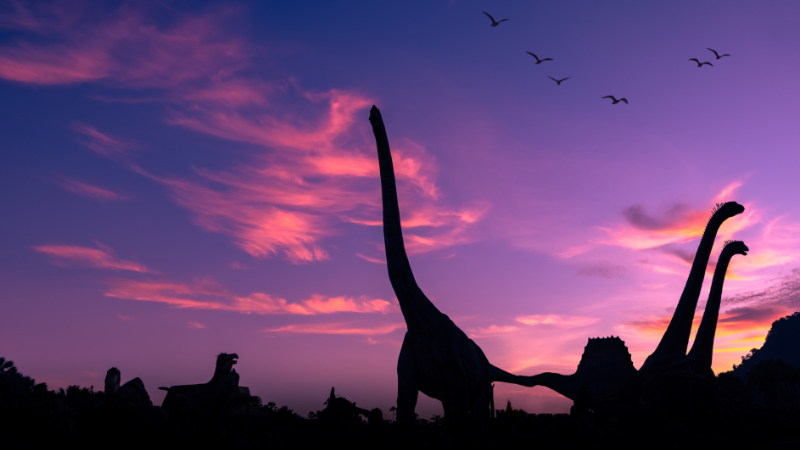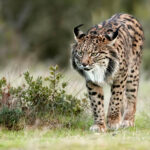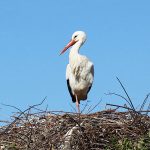Holidays in the Algarve…120 million years ago
By Luís Azevedo Rodrigues (Paleontologist, PHD)
After a year and a half of uncertainty, anguish and hope, many are dreaming of a summer holiday. The Algarve is synonymous with holidays for many Portuguese and foreigners.
But when we think of the Algarve, what appears in our imagination? Maybe heat, calm sea, palm trees, our towels on a natural sand mattress close to a rocky cliff? At the end of the day, we can dream of eating some prawns or clams while anticipating a lazy dinner, where we will enjoy a sea bream or sea bass? The essential sardines are, of course, mandatory even though it means we go home smelling a bit fishy! But enough of the Algarve in 2021. Our holiday challenge is to imagine the Algarve 120 million years ago!
My suggestion is a vacation in the Lower Cretaceous, approximately 120 million years ago (Ma), a phase in which dinosaurs left their footprints on Praia da Salema, the layers of multicoloured sediments were deposited in Praia da Luz and the appearance of the first flowers were recorded.
OUR DESTINATION
The Iberian Peninsula was an isolated block, an island, as Saramago wrote, “a Stone Raft”.
The opening of the Atlantic continued the separation of Iberia from the American continent and, at that time, this “stone raft” was located further south, at a palaeolatitude of 30o north, which would correspond to Agadir, in Morocco, Cairo or even Houston or New Orleans, in the USA.
Travel to Brazil and the USA was also very cheap, if there were planes (and people, for that matter!), since the fragmentation of the huge supercontinent Pangea had already begun.
The Iberian Peninsula was thus between two oceans: to the east, the Neotethys, and to the west, the young and still narrow Atlantic Ocean. To the south, the Gibraltar Fault separates us from Africa, and to the north, another natural border on the Bay of Biscay kept Europe at bay.

CLIMATE
Although at the beginning of the Cretaceous the climate of the Algarve was similar to today, the greatest climatic differences were global. They resided in the fact that temperatures at the poles were much higher than today, causing the poles to have no ice in that period, 120 million years ago.
The fact that the poles were much hotter than today is justified by the greenhouse effect at that time, the result of the great volcanic activity that the continental separation movements caused. A tropical current from the east entered the still small Atlantic, releasing heat to the north and warming the north pole. As a result of the melting of these large masses of ice at the poles, the average sea level was much higher than today – this rise in seawater reminds us of something, doesn’t it?
Was the climate on the Iberian Peninsula a tropical, hot and humid climate, exotic enough for a holiday in the Algarve?
THE BEACHES
The general relief of the Iberian Peninsula was smooth, with no great mountains or elevations to highlight at this stage of the Earth’s history. As for the coastline, the most important thing for any bather to know – where is the beach?

Generally speaking, we can say that the coastline receded as time went on, from a coast that was almost at Silves and between Faro and Loulé, 142 million years ago, to beaches well north of Silves and Loulé, 113 million years ago. It should be noted that going to the beach in Lagos implied a time-consuming journey into the countryside.
This general advance of the sea, with variations, because we must not forget that we are talking about millions of years, was mainly due to different climatic conditions, absence of ice at the poles, as well as variations in the depth of the sea during this period. Approximately 125 million years ago, for those who would venture to dive off the coast around Faro, they could observe a type of already extinct bivalves (Rudists) that would contribute to the so-called bio-buildings, a little like the reefs made by corals.
These extinct bivalves existed from the Upper Jurassic to the end of the Cretaceous. Their shells were thick and very different from each other (one conical and one flat), and it was at the base of the first one that they were fixed to the sea bottom. Perhaps diving to observe fossils in those shallow, warm, slightly turbulent seas would have been a more adventurous tourist attraction?

LANDSCAPE AND PLANTS
Would we have the same landscape pleasure in the Algarve at the time of the dinosaurs as we have today?
Flowering plants (angiosperms), dominant in today’s landscapes – from herbs to wildflowers and fruit trees – began their dominance on Earth approximately 120 million years ago. The plant species that we could observe in the landscape of our tourist experience are conifer woods (the probable Watsoniocladus proposed by Paulo Fernandes, based on pollen analysis, in Praia dos Arrifes), cycladophytes, ferns and gingko. In the Lower Cretaceous, all the present conifer families were already represented, including the pine group (Pinaceae) and the araucaria group (Araucariaceae), thus giving a more familiar image to the landscape of the past.
The landscapes of southern Portugal, currently dotted with various trees, such as the cork oak (Quercus suber), date back only 30 million years (Oligocene), thus making the Algarve landscape very different to that of today. Buying cork handicrafts would be impossible and, if there were wine, how would the bottles be corked?
Another plant that is a trademark of the Algarve, both for its mark on the landscape and its fruit, is the almond tree (Prunus dulcis). However, we would still have to wait 70 million years since its oldest relative appeared in North America “only” 50 million years ago, much later than our imagined Lower Crustaceous holiday destination!
Golf courses were also very far from being one of the attractions
of the Algarve since grasses (including different types of grass, but also, for example, maize or rice) had not yet appeared. The oldest fossils of these plants date from after the disappearance of the dinosaurs (66 million years ago). Although grass remains have been identified in fossilised “cocoons” (coprolites) of dinosaurs. Recent studies date the appearance of this group of plants to around 120 million years ago. Still, even so, golf courses, razor clam rice or the typical xarém, made of corn, all involving grasses, will have to wait a few more million years.

EATING OUT
If, in 2021, one of the attractions of the Algarve is the sardines, 120 million years ago, we would have to give up this delicacy since the sardines (Sardina pilchardus) only appeared approximately 3 million years ago, with fossils from Italy.
The oldest relatives of the sardine appeared soon after the extinction of the dinosaurs, 66 million years ago. If we wanted, for example, to eat sea bream on our holiday, we would have to wait another 80 million years to enjoy this fish.

Although cephalopods have populated the seas for over 500 million years, the squid (Loligo vulgaris) did not yet exist as a group in the Lower Cretaceous. If paleo-tourists want to delight in something similar, we suggest trying some belemnites, an extinct cephalopod, very similar to today’s squid, but unlike the latter, they had an internal shell.
Still, as a trademark (and potential gastronomic) image of the Cretaceous seas, we have another marine cephalopod mollusc – ammonites. A diverse group of animals, molluscs with flat spiral shells and sizes ranging from a few centimetres to over two metres in diameter (estimated value for Parapuzosia seppenradensis) similarly vanished in the mega- extinction of the late Cretaceous. Another dish to try?

Another of the Algarve specialities are the amêijoas or clams (Ruditapes decussatus). These delicacies, both bivalves, would not exist yet, but, as an experimental gastronomic alternative, we suggest rudists, which, as we have seen, would have existed off Faro and Tavira 125 million years ago. Despite their very thick shells, there is always the possibility of a pleasant discovery for the palate, good to tell family and friends about as no one has tasted them for 66 million years – the time travel agency returns your money if not.

CONCLUSION
By way of conclusion, this exercise – touring the past of the Algarve’s natural history, had as its main motivation to present very, I repeat, very briefly some of the information we currently know about this time on Earth and the Algarve in particular. This introduction was not intended to be an exhaustive survey of the geological and palaeontological information we currently know.
Luís Azevedo Rodrigues (Paleontologist, PhD) is the Executive Director of the Centro Ciência Viva de Lagos.
Acknowledgements:
Paulo Fernandes (University of Algarve) Pedro Terrinha (IPMA)
Pedro Proença Cunha (University of Coimbra)
References
Correia, F., 1989. Bistratigraphic and microfacies study of the carbonated Cretaceous of the Portuguese Southern Sedimentary Basin (Algarve). PhD Dissertation, Faculty of Sciences of Lisbon, 400 p.
Penn, S.J., Sweetman, S.C., Martill, D.M., & Coram, R.A. (2020). The Wessex Formation (Wealden Group, Lower Cretaceous) of Swanage Bay, southern England. Proceedings of the Geologists’ Association.
Rodrigues, L.A. and Agostinho, M. (2016) Lagos – Urban Geology and Paleontology Guide. Lagos Ciência Viva Science Center Editions, 124pp. ISBN 978-989-99519-2-1.
Rodrigues, L.A. and Agostinho, M. (2016)a Tavira – Urban Geology and Paleontology Guide. Lagos Ciência Viva Science
Center Editions, 120pp. ISBN 978-989-99519-0-7
Taylor, T.N., Taylor, E.L., M.C., Krings. (2009). Paleobotany, Second Edition The Biology and Evolution of Fossil Plants.
Willis, K.J, & McElwain, J.C. (2002). The evolution of plants.













